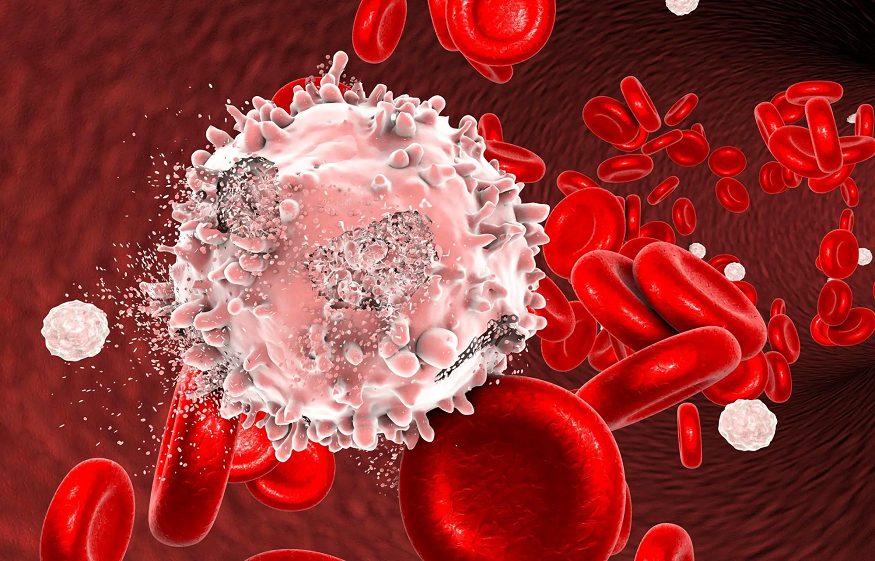Today, more than 50% of affected patients are elderly, while the rest are children or young adults . They can develop three major forms of blood cancer: myeloma , lymphoma or leukemia. Treatment for the disease depends on the type of cancer , how aggressive it is, and how advanced it is. It is mainly based on chemotherapy, radiotherapy, bone marrow cell transplantation and targeted therapies.
1. Definition of Blood Cancer
Blood cancers, or hematological cancers, are also referred to as hematological malignancies. Each year, nearly 35,000 French people discover that they have it . While other cancers start in an organ, blood cancers start in the bone marrow. The latter produces and renews hematopoietic stem cells, at the origin of all blood cells, namely red blood cells (oxygen transport), white blood cells (defense of the body), and platelets (coagulation) . In patients with hematological cancer, an anomaly is expressed at a certain stage of maturation of these stem cells. Generally, the earlier it appears in the process, the more canceris aggressive. Today, according to AbbVie, there are three main categories of blood cancers :
Leukaemias : localized in the bone marrow and in the blood, associated with an abnormal overproduction of white blood cells, these are the most frequent pediatric cancers. A distinction is made between hairy cell leukemia (rare), acute, lymphoblastic or myeloblastic leukemia, and chronic leukemia, such as Waldenström’s disease , chronic lymphoid leukemia or chronic myeloid leukemia;
Lymphomas : 5th of the most frequent cancers, they concern the lymphatic system, the tumors are located in the lymph nodes. There are two main forms: Hodgkin’s lymphoma and non-Hodgkin’s lymphoma (90% of lymphomas, including diffuse large B cell lymphoma, T lymphoma, or even follicular lymphoma);
It should be noted that other bone marrow diseases exist outside of these three categories, and are considered hematological cancers. These are essentially myeloproliferative syndromes (including polycythemia vera and thrombocythemia, linked to mutations that block the proper production of blood stem cells in the bone marrow), and myeloproliferative neoplasms, which involve excessive production of blood cells . The evolution of the disease, the prognosis, the symptoms and the treatments are very variable according to the type of blood cancer, and the patient.
2. Symptoms: what are the signs of blood cancer?
There is great variability when it comes to blood cancers. From one patient to another, the symptoms can differ greatly. Sometimes the clinical signs are very pronounced, while in some people they go unnoticed and are less severe ( loss of appetite , general fatigue , etc.). In patients with acute leukemia, the clinical signs come on suddenly, sometimes within a few days. We most often observe: anemia (low red blood cells in the blood), paleness, fatigue, rapid heartbeat , shortness of breath, bleeding (gums, nose) linked to thrombocytopenia (low platelets), unexplained hematomas, and leukopenia(decrease in white blood cells) associated with an increased risk of infection.
Other, less common signs may appear: enlargement of the lymph nodes , spleen or liver (usually painless symptoms), swollen and painful gums, small skin lesions (leukemids). In patients with chronic leukaemias, the disease remains silent and without symptoms for a long time. It can be discovered incidentally, during a routine blood test (patients have an abnormally high level of lymphocytes). Patients with lymphoma may present with: fever, itching, night sweats, unexplained fatigue, swollen glands or a persistent cough. Finally, myeloma essentially involves a strong weakening of the bones, and a significant risk of fractures.
3. The causes: how does a blood cancer get caught?
There is a wide variety of blood cancers. Each of them has different risk factors, and more or less known. According to the Institut Curie contre le cancer, the factors highlighted by the research are multiple :
Genetic predispositions and family history (with or without a clearly identified gene): this is the case for several blood cancers, and in particular for chronic myeloid leukemia which involves the Philadelphia chromosome; exposure to certain substances: benzene and ionizing radiation are implicated in leukemia, while non-Hodgkin’s lymphoma is common among farmers regularly exposed to plant protection products; contact with certain viruses: for example the Epstein-Barr virus or hepatitis C; a history of cancer: which required chemotherapy or radiotherapy; a weakened immune system: by an immunosuppressive treatment, an HIV infection or a pathology linked to immunity.


